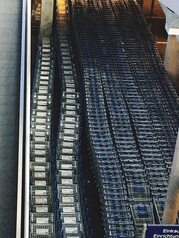The Hidden Value of Connectivity in the Real Estate Market

The value of connectivity in the real estate market goes beyond mere location. In an increasingly interconnected world, buyers are looking for properties that not only offer comfort and style but also access to transportation networks, digital services, and interactive communities. Discover how connectivity can be the decisive factor that boosts the appreciation of your real estate investment and elevates your quality of life in Costa Rica.
Connectivity as a Key Factor in Real Estate Decision-Making
Connectivity has become a fundamental aspect in real estate decision-making, as it directly influences the quality of life of residents and the valuation of properties. Current buyers not only consider the physical condition of a home or its interior design; they also evaluate how it fits into their lifestyle. Proximity to transportation routes, access to high-speed Internet, and closeness to shopping centers, schools, and recreational areas are elements that add significant value to any property. In this context, homes located in areas with good connectivity tend to be more demanded and therefore experience a notable increase in their appreciation.
Furthermore, connectivity fosters a sense of community among residents. Properties that are well-connected often attract individuals with similar interests, making it easier to create social networks and lasting bonds. This aspect is particularly relevant in a world where remote work and digital interactions are gaining ground. By choosing a property with easy access to digital services and collaborative spaces, buyers are not only investing in a place to live but also in a lifestyle that promotes social interaction and overall well-being. Thus, connectivity is not merely a luxury; it is a strategic necessity for those looking to maximize their real estate investment while enjoying a higher quality of life.
2. Impact of Transportation Networks on Property Value
Transport networks play a crucial role in determining property values, as they facilitate access to different urban and suburban areas. When a property is located near train stations, bus stops, or highways, its appeal significantly increases for potential buyers. This accessibility not only saves time on commutes but also opens up new job and recreational opportunities, making these locations more desirable options. Therefore, properties situated in well-connected areas tend to experience an increase in their appreciation over time.
In addition to the immediate impact on economic valuation, proximity to transportation networks can also influence the quality of life for residents. By reducing the time spent on daily commuting, homeowners can enjoy their homes and communities more. Efficient connectivity fosters an active and socially interactive lifestyle, where people have greater access to essential services such as supermarkets, hospitals, and educational centers. In summary, investing in a well-connected property is not only a smart financial decision but also a choice that enhances the overall well-being of the household and its inhabitants.
3. Technology and Innovation: A New Horizon for Investors
Technology and innovation are transforming the real estate market, creating a new horizon for investors looking to maximize their return on investment. Properties that integrate advanced technological solutions, such as home automation systems, high-speed connectivity, and intelligent management platforms, are not only more attractive to buyers but also appreciate in value more quickly. Smart homes enable a more efficient and comfortable lifestyle, which is an increasingly desired aspect for modern consumers. Therefore, investing in properties that incorporate these innovations represents a strategic opportunity in a competitive market.
Additionally, technology-driven interactive communities foster a sense of belonging and facilitate social networking among residents. Shared spaces equipped with digital tools allow inhabitants to easily communicate and organize joint activities, enhancing the neighborhood's appeal. This approach not only improves quality of life but can also result in lower tenant turnover and greater financial stability for investors. In this context, connectivity goes beyond being a mere feature; it becomes an essential asset that can significantly elevate the perceived value of any property within the dynamic real estate landscape.
4. Connected Communities: The Future of Urban Development
Connected communities are redefining the concept of urban development, offering an environment where social interaction and technology intertwine to enhance the quality of life for their inhabitants. In these communities, common spaces such as parks, squares, and recreational areas become focal points that encourage neighborly encounters, creating a sense of belonging and collaboration. Moreover, the integration of digital services and online platforms facilitates access to relevant information and community resources, allowing residents to actively participate in the management and improvement of their environment. This type of connection not only promotes a healthier and more dynamic lifestyle but also increases the area's appeal to future buyers and investors.
The evolution towards more connected communities also involves an innovative vision of urban mobility. With infrastructures that prioritize sustainable transport such as bike lanes and efficient public transport systems, these areas seek to reduce dependence on cars and promote alternative forms of commuting. By incorporating smart technology into their transit systems and public services, connected communities can optimize traffic flows, enhance safety, and provide practical solutions for the daily needs of their residents. This comprehensive approach not only elevates the overall quality of the living environment but can also result in a significant increase in long-term real estate value.
5. Case Studies: Real Estate Successes Driven by Connectivity
A clear example of the positive impact of connectivity on the real estate market can be observed in urban projects that have incorporated smart technology and high-speed internet access. In a recent residential development in the metropolitan area, the developers decided to implement a home automation system that allows residents to control lighting, heating, and other devices from their mobile devices. This approach not only attracted young professionals who value convenience and efficiency, but also significantly increased the resale value of the properties, highlighting how connectivity can be a catalyst for real estate success.
Another notable case is the development of planned communities around technology hubs and coworking spaces. These areas have seen a surge in demand due to their ability to attract entrepreneurs and remote workers. By offering not only appealing housing but also proximity to essential digital services and collaborative networks, these projects have experienced significant appreciation. The ease of access to public transport and services such as cafes, gyms, and parks has made these communities even more desirable. Thus, it is clear that integrating connectivity into urban design is key to fostering an environment where people want to live and work.
6. Strategies to Maximize Value Through Connectivity
To maximize the value of a property in the real estate market, it is crucial to consider connectivity as a determining factor. This involves not only evaluating proximity to transportation routes and public services but also the availability of digital infrastructure that allows residents to enjoy fast Internet access and advanced technology. Properties located in areas with good connectivity tend to attract more buyers, as they offer greater amenities and facilities for working from home, studying, or simply enjoying digital entertainment. Thus, by investing in connectivity-related improvements, such as fiber optic installations or smart home management systems, one can significantly increase the appeal and value of a property.
Additionally, integrating common spaces that encourage social interaction among neighbors can be an effective strategy to increase the perceived value of a community. The creation of shared areas such as coworking spaces, recreational zones, and community events not only improves the quality of life for residents but also establishes a sense of belonging and social cohesion. This is particularly appealing to new generations who prioritize living in environments where they can work and socialize without logistical challenges. Therefore, developing strategies focused on connectivity not only enhances the economic value of real estate investments but also contributes to the overall well-being of its inhabitants.
7. Future Trends in Connectivity and Their Influence on the Real Estate Market
Connectivity is constantly evolving, and future trends point to an environment where technology will be even more integral to our daily lives. The expansion of 5G networks and the development of smart cities are transforming not only how we communicate but also how we interact with our surroundings. In the real estate sector, this translates to properties that offer features such as advanced home automation, smart security systems, and instant access to digital services. These innovations not only make daily life more convenient but also significantly increase the perceived value of properties in the market.
As more people prioritize connectivity and digital quality of life in their housing search, real estate developers have a unique opportunity to adapt to these changing demands. Communities that integrate collaborative spaces, interconnected green areas, and sustainable technological solutions will attract a broader and more diverse audience. Additionally, those buyers who value connectivity as a decisive factor will be willing to invest more in properties that offer these innovative features. Ultimately, the ability to anticipate and respond to these trends will be key to maximizing return on investment in the real estate sector.



